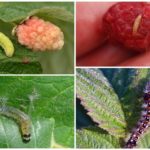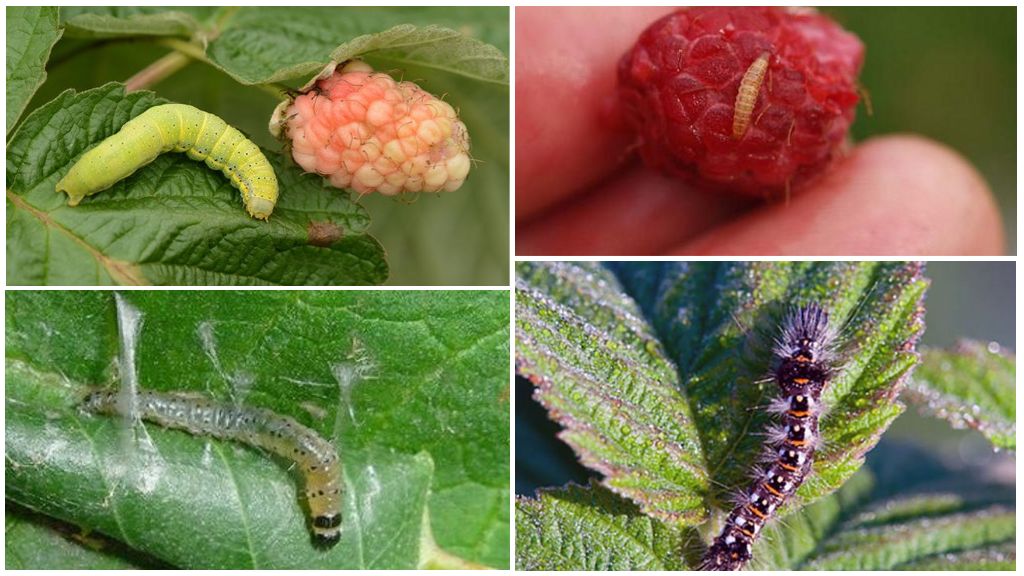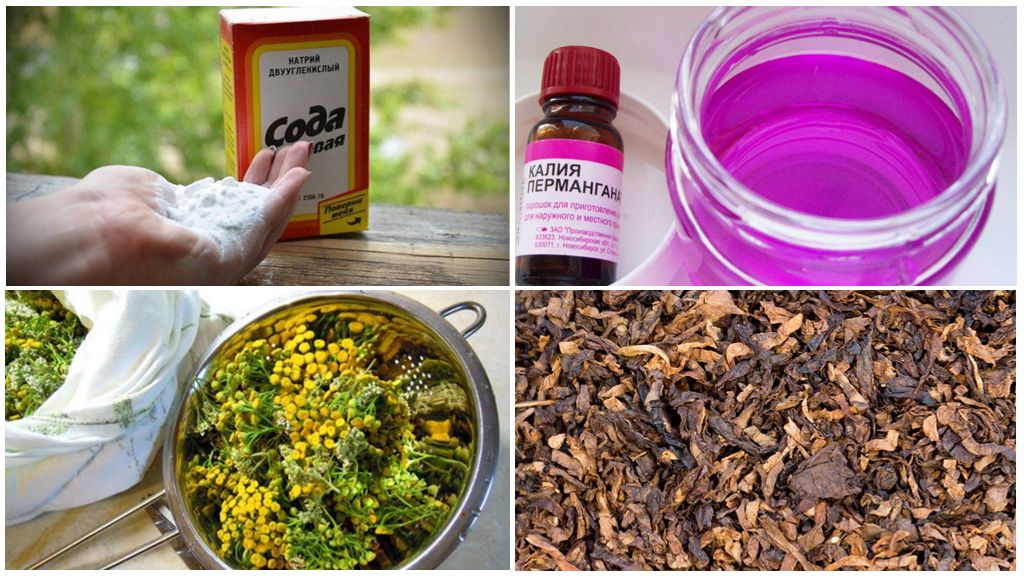How to get rid of caterpillars on raspberries
Content
- Caterpillars on raspberries
- Caterpillar Remedies
- Folk methods of dealing with caterpillars
Caterpillars on raspberries - one of the most common problems, due to which the harvest of berries is greatly reduced. There are a lot of pests eating the leaves and fruits, but the most popular are the glass bowl and stem fly. Struggling to preserve the crop should be as soon as pests appear, and prevention should be made a mandatory annual procedure.
What pests are on raspberries
Soft leaves, juicy berries and characteristics of plant growth are favorable factors for the development of various pests on them. See the shrubs like many butterflies and caterpillars. If you ignore them and take no action, then the number of crops can seriously decrease.
The most popular crimson pests:
- Raspberry beetle Its appearance leads to a decrease in yield, the presence of worms in the berries and damage to the leaves. The adult beetle has a gray body, the caterpillars have a light body. Imago eat flowers on the bushes, and the larvae feed on the kidneys.
- Stem fly. Pest that appears in May-June. He lays eggs in the leaves and tops of young stems. Hatching caterpillars eat the leaves and cause them to dry.
- Stem gallitsa. The adult individual looks like a small mosquito with transparent wings. Lays eggs on the stems. Black and orange caterpillar on raspberries can be introduced into the stem and eat it from the inside.
- Glass cup Caterpillars use the stems core as food. As a result, young shoots dry and disappear. Females lay directly next to the raspberry stalks.
On a note!
Photo caterpillars on raspberries help to quickly identify the pest. To effectively deal with them, you should also consider the characteristics of the life cycle of each insect.
It is necessary to fight against the leafworm on raspberries and other pests in a timely manner in order to preserve the harvest and to protect the family from chemical reagents. The little wisper affects almost all fruit and berry crops in the garden: apple trees, pears, currants, gooseberry, Kalina and even roses and other flower shrubs. For processing, you should choose universal drugs contact or systemic action.
When and how to deal with pests chemicals
Caterpillar Fighting, flies and beetles on raspberries can occur in several stages. The selected drug will largely depend on the degree of infection and the time of year. You can handle raspberry bushes in spring, summer or autumn.
Important!
It is forbidden to use chemicals against pests during flowering plants.
The difficulty of getting rid of pests lies in the fact that the raspberry berry does not have a dense skin that could protect it from ingress of chemical reagents.In this case, the risk of human poisoning increases significantly. To protect yourself and your family, you should carefully read the instructions and follow the terms specified in the instructions for use of reagents.
When choosing an effective method of how to deal with caterpillars on raspberries, you should consider the characteristics of each drug and the degree of infection of plants. Processing of bushes and soil is allowed only in spring or autumn. Chemistry is allowed to apply before the first inflorescences unfold on the bushes.
How to process raspberries from caterpillars:
- Karbofos. Effective and inexpensive tool. Available in the form of granules, powder, tablets and emulsion. To protect the raspberries, it is necessary to prepare a solution. To do this, dissolve 90 g of money in a bucket of water and process the shrubs. Price per pack of 30 g from 50 rubles.
- Spark. The drug is based on permethrin. Available in several variations from classic to enhanced action. Sold in the form of emulsions or tablets. Just apply. Price from 25 rubles.
- Metaphos. Light gray powder or emulsion. Active ingredient dimethylnitrophenylthiophosphate. It has a contact action. It has high toxicity.Resistant to high ambient temperatures. Price 30 rubles per ampoule.
Also used Konfidor, colloidal sulfur, Tsidial, Fufanon. From biological preparations, Guapsin and Bitoxibaccillin have a high efficiency.
Feedback
We always use Malathion from many pests in the country. Inexpensive and very effective. We use it infrequently, as we try to prevent the development of pests or use proven folk remedies. But with a strong infection, we always spray the cultures with Carbofos. Helps a lot.
Katerina, Kharkiv
Feedback
I am afraid to apply chemistry at any stage of growing garden crops. But last summer, the bushes simply attacked the caterpillars and folk remedies were powerless. Neighbor recommended Guapsine. This is a biological product that has almost no negative effect. I bought for 100 rubles a bottle of 500 ml.
Arina, Liski
Folk remedies
Simple folk remedies will help to get rid of pests on raspberries. To do this, use powders or herbal infusions.
The following recipes have proven themselves well:
- Soda.Its disinfectant and bactericidal action helps to get rid of insects and bacteria on the bushes. To use, dissolve 50 mg per bucket of water and process the shrubs.
- Tobacco. Pour 1 cup of dry tobacco with 2 liters of water. Boil the broth for an hour, then cool. For processing, the resulting concentrate is diluted with pure water in a ratio of 1: 3. Spray the bushes. It is also possible to water the soil with a prepared agent before digging 2 times a year.
- Infusion of tansy. A bucket of water will require 300 g of a dry plant or a third of a bucket of fresh inflorescences. Pour water and insist at least a day.
- Potassium permanganate It will help to avoid the appearance of caterpillars in the spring. To prepare the solution, stir 10 crystals of potassium permanganate in a bucket of water. Spray the shrubs.
- If the moth on raspberry was got, dry mustard will help. 100 g of powder mixed with boiling water to a thick cream. Then add mush in a bucket of water and process the bush.
Feedback
For the prevention of caterpillars on raspberries and currant I use soda solution. I spray once a week. Safe and very effective.I use chemical preparations only in extreme cases.
Angelina, Moscow
Feedback
I tried to plant mustard in a bucket of water to process garden shrubs. Effect not noticed. If the caterpillars and became smaller, then not much. I had to buy special insecticides, and only then was the result.
Elena, Mytishchi
How to prevent infections
It is always easier to prevent the development of pests on raspberries than to suffer harvest losses. To protect the crimson bushes, you should follow these recommendations:
- Crop. Every year before sending the plants for wintering, it is necessary to prune dry and damaged branches.
- Spring thinning bushes. This will improve air circulation in the root system.
- Keep the area clean. All rubbish and weeds should be immediately taken out of the garden and burned. Picked plants lying on the beds, contribute to the spread of spider mites.
- Ensure that the soil is loose. To do this, throughout the growth of raspberries periodically loosen the ground.
Important!
Affected stems should be cut at the root. The exceptions are parts infected with stem gallfly.In this case, pruning should be slightly lower than the characteristic swellings detected.
Regular vegetation control can reduce the number of pests on raspberries. To do this, once a week it is necessary to carefully inspect each hive and, if diseases or pests are detected, immediately remove the affected parts. If various harmful insects are often found on the site, it is possible to treat the stands with special chemicals once a year for prevention. It is best to do this in the spring with the help of Karbofos or Aktellik.
To save the crop from the crimson beetle, I cover the bushes with non-woven material for the period of bud formation. When the flowers begin to bloom, the protection is removed.
Thus, getting rid of caterpillars on raspberries will not be easy. In order to preserve the crop as much as possible and not be zealous with chemicals, it is better to regularly carry out simple methods of prevention. Cleanliness at the site and control over the ripening of plants will be the key to the absence of pests and the generous harvest of not only raspberry berries, but also other crops.











